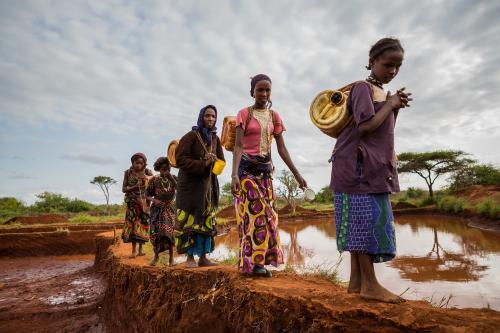Given the all-consuming focus in Europe and beyond on the refugee issue, one would have expected the COP21 meetings and its media coverage to focus more on displacement as a result of climate change. The numbers are beyond alarming, though not in the immediate, and perhaps therein lies the shortsightedness. According to the Internal Displacement Monitoring Center (IDMC), since 2008 an average of 26.4 million people a year have fled their homes due to environmental disasters. In the same period, the numbers displaced as a result of conflict stands at an annual average of 6.2 million. The Office of the United Nations High Commissioner for Refugees (UNHCR) predicts even greater displacement due to climate change in the years to come. Ominously, the IDMC notes that the likelihood of displacement due to climate disaster is 60 percent higher today than it was four decades ago.
A strong lobbying effort on climate-induced displacement was made by the Advisory Group on Climate Change and Human Mobility. This is a key group, bringing together the UNHCR, other U.N. agencies, the International Organization for Migration, the Norwegian Refugee Council/IDMC, Refugees International, the Center for International Relations Studies of Sciences Po (Sciences Po-CERI), and the Arab Network for Environment and Development (RAED). The group pushed hard to ensure that the issue would be part of the agreement to be reached in Paris.
Initially, the draft agreement for the Paris climate talks included the recommendation that a climate change displacement coordination facility be established to provide “organized migration and planned relocation” and financial compensation for those displaced by climate change. It was then removed from the document, largely due to opposition by Australia. The proximity of the low-lying islands of Tuvalu, Solomon Islands, Kiribati and their vulnerable populations doubtless played a role. While Canberra has spent some $50 million in climate resilience projects in the Pacific and contributed $200 million to the Green Climate Fund, it may not want to lose its ability to deal with the issue on its own terms. Australia is unlikely to be alone as the impact of climate change on human migration and other challenges increases. The more powerful and those most responsible for global warming—Australia is the highest per capita CO2 emitter in the world—could also move to deal with climate change issues, including displacement, on their own terms and their own timelines. Yet the see-saw continues; it is now back in the latest draft agreement though hanging precariously.
In the context of the current refugee crisis in the Middle East and Europe, the impact of climate change is already surfacing. In Syria, a drought and ineffectual government response from 2007 to 2010 that led 1.5 million migrants from rural communities to move into cities already crowded with some 1.5 million Iraqi refugees, is often cited as a contributory factor in the conflict. Columbia University Professor Richard Saeger, who authored the study that made the case on the impact of the drought in Syria, notes that “Syria is not the only country that is affected by this drying. Lebanon, Jordan, Israel, Iraq, and Iran are too.” What is clear is that while climate change generally needs other contributory factors to lead to conflicts, it certainly increases the vulnerability of these countries as the region feels the stress of declining water resources, rising seas, and warming weather.
A warmer planet will mean more displacement
Others in the region have their own vulnerabilities. Egypt, by far the most populous Arab nation, faces a number of climate change challenges, including a warming, rising Mediterranean that is expanding into the Nile Delta and seeping into the Nile’s water, decreasing agricultural productivity just as the country faces a new population boom. No fewer than 10 million people are expected to be displaced over the next 30 years. Longer-term projections are much direr. Yemen is withdrawing almost 169 percent of its renewable water resources, meaning that it is using water far faster than it can replenish its supplies. The capital Sanaa could lose its aquifer at any time. The list is nearly endless, including an increasingly dry Sahel with many living there being displaced at an accelerating pace in a belt from Senegal to Eritrea. Some are heading north to Europe.
So while the mention of migration is back, the real battle now is where the reference shall appear. Most developing countries want climate displacement under a framework of “loss and damage” to get compensation from the worst emitters of carbon dioxide from the developed world. The developed world prefers a framework of adaptation in which they would subsidize the cost of adaptation but not pay for compensation. Walter Kaelin, from the Nansen Initiative, a group trying to rally international action to protect climate-induced migrants, notes that “if it’s mentioned in a general way then you can build on it… This has not been achieved yet.” Let us hope we get there.
A good place to begin would be legal protection for climate-induced displaced people. Currently, there is only a non-binding agreement on internal displacement from 1998. Aside from legal, protected status, what is also needed is a coordination mechanism and help with funding for vulnerable populations, as noted in the recommendations of the Advisory Group. The coordination mechanism is now in the latest draft. The most vulnerable are those in poorer countries that lack the resources to fund large resettlement programs, flood relief channels, large water transfer programs to replenish aquifers, etc. None of this is cheap but it is providing a global public good. Europe’s current refugee crisis is but a small, compressed example of the challenge.



Commentary
Refugees: Displaced from the Paris climate change agreement?
December 7, 2015